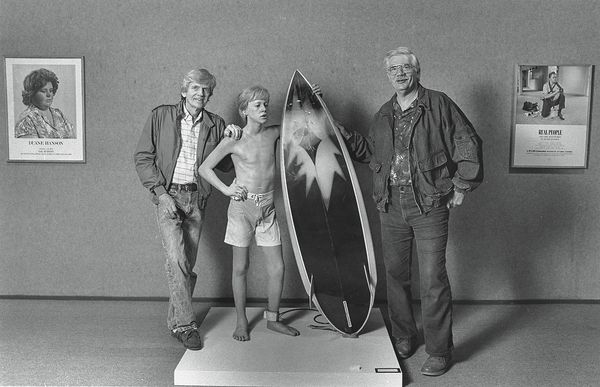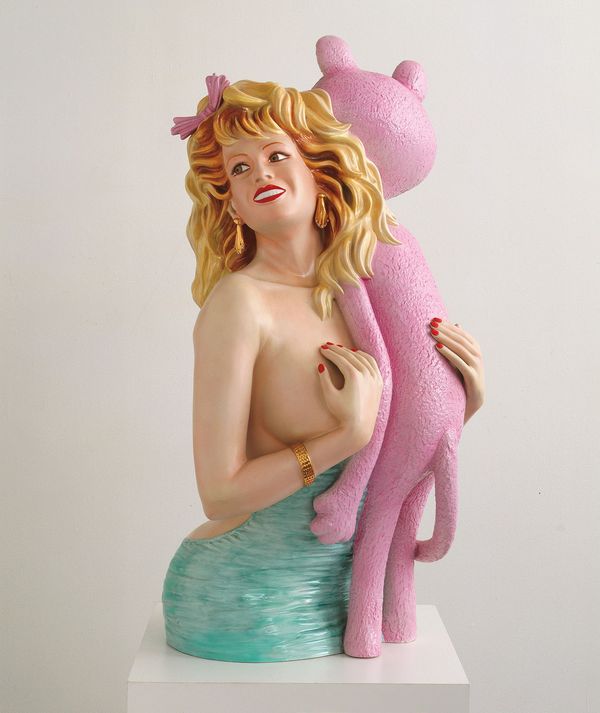Duane Hanson Surfer, 1987. Estimate: £200,000-300,000.
20th Century & Contemporary Art Day Sale at Phillips London, 14 February.
Surfer, 1987, executed at the height of Duane Hanson’s practice, encapsulates the artist’s unflinching observation of and fascination with pedestrian lower-middle-class characters in American society. Capturing his figures in a moment of unguarded thought and reflection, they surprise, amuse and disturb viewers through their arrestingly real depiction. The artist stated "the subject matter that I like best deals with the familiar lower- and middle-class American types of today. To me, the resignation, emptiness, and loneliness of their existence captures the true reality of life for these people … I want to achieve a certain tough realism which speaks of the fascinating idiosyncrasies of our times" (Duane Hanson quoted in Christine Lindey, Superrealist Painting and Sculpture, New York, 1980, p. 130.).
The work takes as its subject a boy, dressed in his sunset-colored swimming trunks as he holds his fiery board in one hand, the other nonchalantly on his hip. He gazes out into the distance, avoiding the eye of the viewer, searching for the perfect wave. Created during a time of worldwide obsession with sportswear, body image and exercise trends, Surfer, 1987, vividly highlights the artist’s captivation with consumer culture while also holding personal significance as the sculpture was modeled after Hanson's son.
Duane Hanson (left) with Surfer at Broward Community College, Fort Lauderdale, in 1987.
© Estate of Duane Hanson/VAGA at ARS, NY and DACS, London 2020.
Image: Broward College Archives & Special Collections, Davie, FL.
Hanson created his perfectly realized figures using auto-filler or polyvinyl, increasingly moving to bronze in his later works. Hand painting each piece, the figures are completed in painstaking detail with wigs, eyes, fingernails and even human hair in some works. Carefully choosing often friends or family as his models, Hanson dresses his figures with notably telling props, creating identifiable personalities. Hanson would often unify elements from different models, finishing his sculptures with delicate embellishments. His works endorse and make the most of ordinary moments, elevating the subject, crediting it as gallery and viewer worthy, conversing with the gallery space, demanding immediate interaction with the viewer. "I am not duplicating life. I’m making a statement about human values." (Duane Hanson, quoted in Thomas Buchsteiner and Otto Letze, eds., Duane Hanson: More than Reality, Stuttgart, 2001, p. 77).
In the turmoil of everyday life, we too seldom become aware of one another. In the quiet moments in which you observe my work, maybe you will recognise the universality of all people.
— Duane Hanson
Hanson’s first life-size, realistic sculptures executed in the late 1960s were reflective of a climate of unrest and social fragmentation raging around him, aggressively confronting issues including suicide, abortion, racial unrest and homelessness, shifting in the 1970s to social commentary on the banalities of daily life. Hanson meticulously observes in unflinching precise detail, resulting in a representation that embodies "something I deeply wanted to say about life around us today" (Duane Hanson, quoted in Martin Bush, Sculptures by Duane Hanson, Wichita, 1985, p. 31.) His experimentations with hyper-realism were born amongst the growing world of Pop Art in America, encouraged by the likes of Jasper Johns and George Segal’s crude plaster casts of living models in domestic scenes conversion of high-art from Abstract Expressionism to a reflection of the everyday.
Jeff Koons Pink Panther, 1988. Porcelain, Museum of Modern Art, New York.
© Jeff Koons, 2020. Image Scala, Florence.
Significantly influenced by those around him, Hanson subsequently also guided the development of figurative art himself. Jeff Koons' Pink Panther, 1988, made one year after the present example, shares the same kitsch quality of small-town Americana, the same plastic surface quality and sheen. Yet Koons creates an idealized figure in stark contrast to Hanson’s real and self-conscious portrayal of youth. Hanson was part of the same generation of American artists such as Robert Gober whose domestic considerations can be understood in Hanson’s importance of the everyday, and John deAndrea’s who implemented the same modeling technique to produce his own nude figures. In Britain, Hanson had a profoundly evident influence on the YBA artists such as Jake & Dinos Chapman.
Throughout his impressive oeuvre and wonderfully captured in Surfer, 1987, Hanson holds up a mirror to society, making us appreciate and elevate the notion of the everyday, as beautifully summarised by the critic Thomas Buchsteiner: "For Duane Hanson, art was life, and life was realistic." (Thomas Buchsteiner, ‘Art is Life and Life is Realistic’ in Thomas Buchsteiner and Otto Letze, eds., Duane Hanson: More than Reality, Stuttgart, 2001, p. 77).


